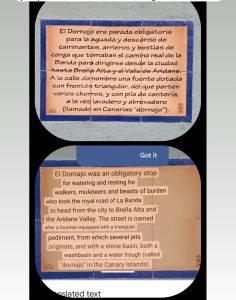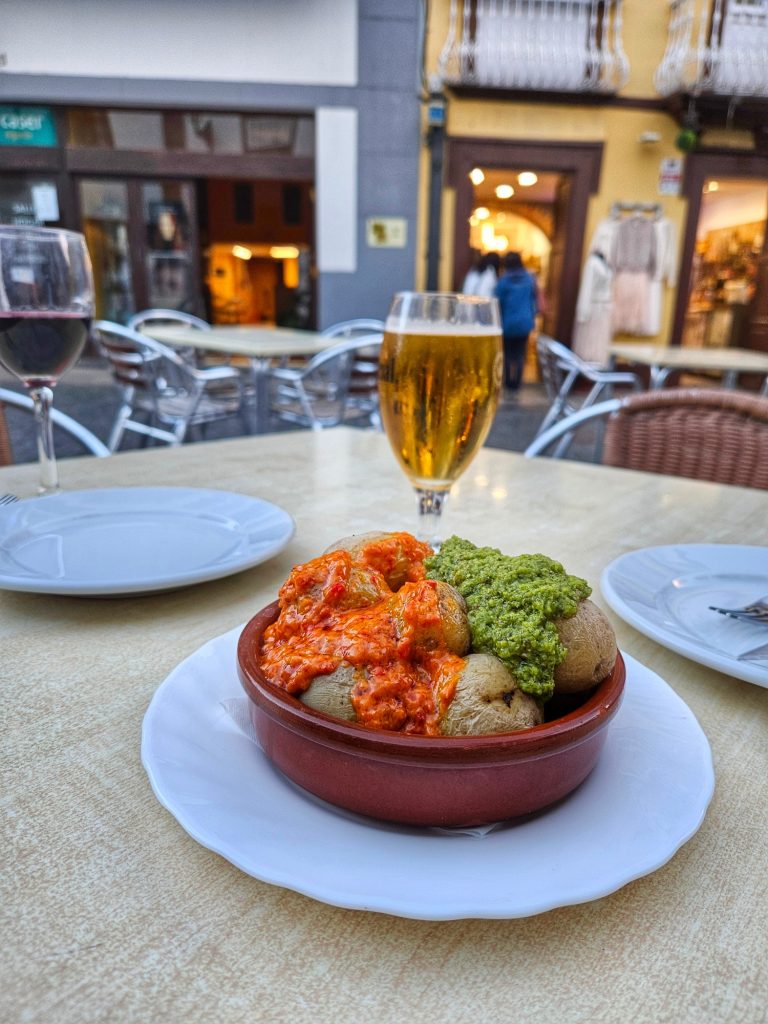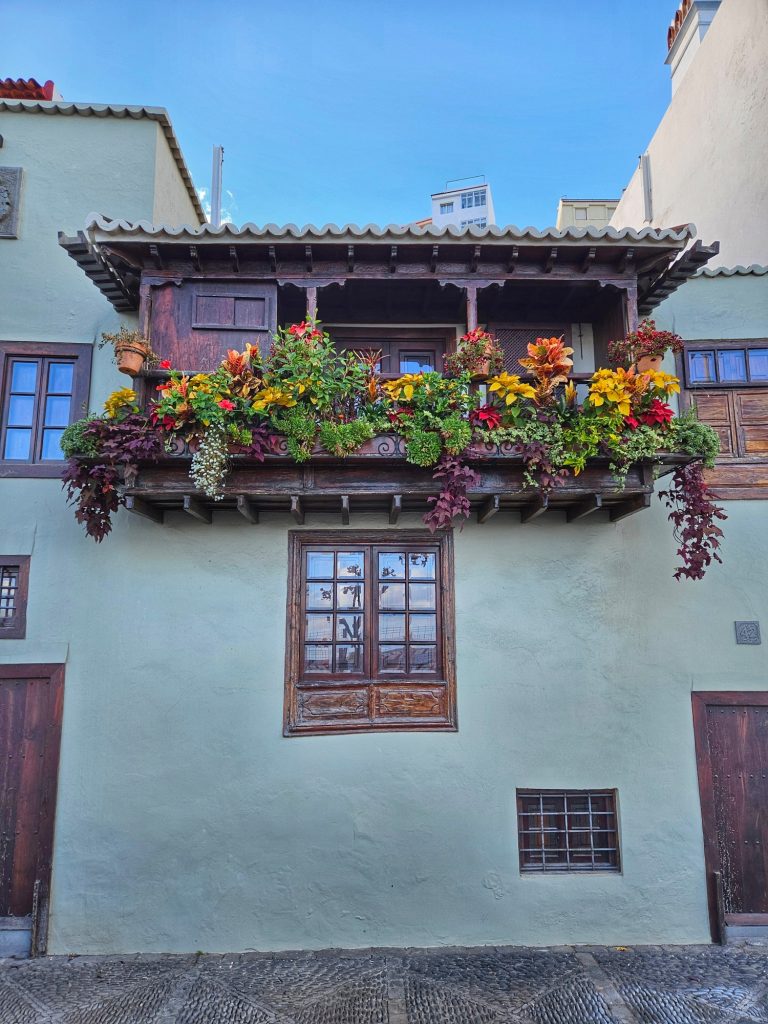It was winter in San Diego County and I’d been home for a few weeks, so… time to start planning a new adventure!
I really had an itch to go to Europe but frankly, winter isn’t the best time to go to there…but wait a minute, where’s the warmest place in Europe in January? The Canary Islands came up, and to get there from the west coast of the USA nonstop it’s easiest to go to Madrid first. Well, I always love going to Madrid. With a few details like how long Mike was going to accompany me and flights to Madrid sorted…the trip was on.
Which of the Canary Islands to Choose?
Neither of us like big resort destinations and a with timeframe of two weeks for the islands, we chose La Palma and Lanzarote, two entirely different experiences in these islands off the coast of Africa.
La Palma
La Palma is called La Isla Bonita “Beautiful Island” with good reason. It is the greenest of the Canary Islands, has majestic mountains, forests, dramatic volcanic landscape, stunning coastlines and pretty, colorful towns and villages…and banana plantations everywhere! I was pretty sure this was going to be my kind of place.
Not so Fun Facts
On September 19, 2021 the Tajogaite volcano erupted, rumbling for 85 days ejecting ash and a river of lava that swallowed up more than 1,000 homes on the west coast of La Palma.
Tips for Visiting
- Get a rental car. Sure there’s buses, but a car is best for the most fun and flexibility.
- Stay in 1 base location – I loved staying in Santa Cruz de la Palma, the small and delightful capital city.
La Palma
A Terrific One Week Itinerary
There’s a lot of driving in this itinerary, but trust me, it’s worth it!
- Day 1
- Pick up the rental car and park in Santa Cruz de la Palma
- Check in, go have some tapas, walk around the pedestrian center and Avenida de Maritima, have some more tapas
- Day 2
- Explore Santa Cruz de la Palma, there’s some fascinating info plaques on the historic buildings
- Day 3 – Drive to explore the volcanic Southwest
- Over the mountain from Santa Cruz de La Palma
- Bodegas Teneguia winery to learn about the volcanic wines
- Volcan de San Antonio visitor center and hike to overlook the chasm left from the 1949 eruption
- Playa de la Zamora restaurant and beautiful view
- Southernmost Lighthouse Fuencaliente and salt flats.
- Day 4 – Drive to the Northeast
- Drive through banana plantations
- Tour and museum of the Archeological site of Tendal
- Hike Los Tilos (closed when we were there) or alternative Cubo de la Galga
- Visit the Charco Azul natural pools
- Visit the La Fajana natural pools
- Day 5 – Drive to the top of the Caldera – Roque de los Muchachos
- View stop Pico de la Cruz and short hike
- View stop Mirador de los Andenes
- Roque de los Muchachos Visitor Center to learn about this world famous observatory
- Drive back from the observatory on LP-109, the most beautiful drive in La Palma
- Day 6 – Drive to Poris de Candelaria and the north again
- Over the mountain to the west
- View stop and cafe Mirador el Time
- Poris de Candelaria fishing village in a cave
- Santo Domingo settlement
- Drive back via the north LP-1 because it’s prettier
- Day 7 – Drive to the West Again
- Over the mountain to the west
- Ecofina Platanologico Banana Plantation Tour
- Back to Santa Cruz de la Palma for a last night
- Day 8 – Leave La Palma
- If you’re based in Santa Cruz de la Palma (recommend!) it’s easy to get to the airport for your flight to wherever…in our case – Lanzarote!
Santa Cruz de la Palma
Exploring the city
Right on Avenida Maritima are historic houses that have wooden balconies, a typical element of traditional Canary islands architecture and a famous sight in the city.
How about a history walk?
Santa Cruz de la Palma has a fascinating colonial history that you can explore on a do-it-yourself history walk. Throughout the town are info plaques explaining the buildings’ history.
The first info plaque we saw was on the wall of a building next to a courtyard high above the lower town in the San Sebastian neighborhood on a street named El Dornajo. In the courtyard was a wash basin and watering trough, called “dornajo” in the Canary Islands. This was a rest stop! It was for all types of travelers, walkers, muleteers, carts and horses taking the royal road from the city over the mountains to Brena Alta and the Aridane Valley. A very fun neighborhood to explore the interesting streets and find all the history plaques on the buildings.

Steps to the upper town 
Google Translate of info plaque 
El Dornajo 
Colonial buildings on La Real 
Beautiful historic buildings on Plaza Espana
Tapas, Tapas, Tapas!
There are plenty of cafe and bar options in Santa Cruz de la Palma, one of the reasons it makes a great base for a week. A must try dish is Papas Arrugadas “wrinkled potatoes”, a signature dish of the Canary Islands. Small new potatoes are boiled in salt water that evaporates leaving the pototoes with a thin layer of salt and wrinkled skins. Traditional and popular, served with red and green salsas, and delicious!

Papas Arrugadas 
Restaurants on Avenida Maritima 
Plaza de la Alameda
Parking
Our Airbnb was right on La Real (The Royal Street) in the pedestrian zone a block from the ocean. Parking can usually be found on Avenida Maritima, the street along the ocean. Any of the spaces with WHITE lines are ok to park in for any length of time. Spaces with BLUE lines have a time limit of 1.5 hours
La Palma Summary
I really liked this island and thought it was perfect having just one home base. My favorite part of the island was the beautiful north, if I were ever to return I’d spend more time exploring there.
We travel not to escape life, but for life not to escape us.
Unknown

























